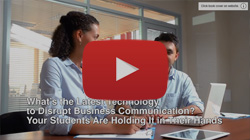
We’ve been following technologies that cover an interesting array of possibilities, from enhancing existing communication modes to replacing at least one of the humans in a conversation to assisting people who have a variety of motor, vision, and cognitive impairments.
They are all across the adoption curve, from technologies that are already approaching mainstream usage (such as bots and gamification) to a few that are closer to the sci-fi end of things (such as holograms and telepathic communication). Many of these systems rely on artificial intelligence, which is reshaping business communication in some profound ways.
All of them present interesting discussion topics for business communication, because they get to the heart of matter, which is trying to exchange information and meaning in the most effective and efficient ways possible.
This post is about technologies that are shaping the future of communication.
Sourced through Scoop.it from: blog.businesscommunicationnetwork.com
Read more






